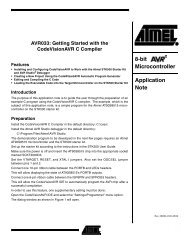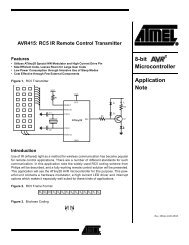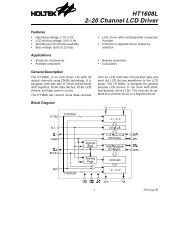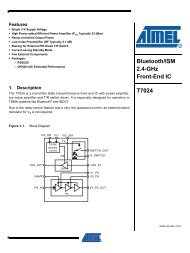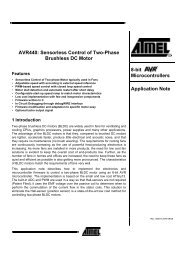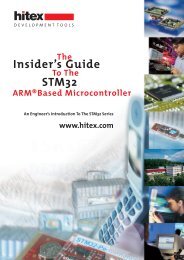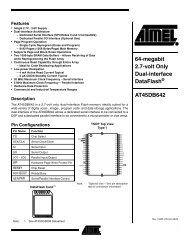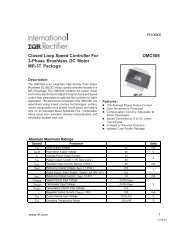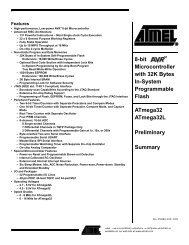AVR501: Replacing ATtiny15 with ATtiny25
AVR501: Replacing ATtiny15 with ATtiny25
AVR501: Replacing ATtiny15 with ATtiny25
Create successful ePaper yourself
Turn your PDF publications into a flip-book with our unique Google optimized e-Paper software.
2 General Porting ConsiderationsBetween the <strong>ATtiny25</strong> and <strong>ATtiny15</strong>, some registers and register bits have changedname but note that they preserve the same functionality. They are all listed later inthis document.In relation to code porting, it is an advantage if register names and bit definitions hasbeen used as substitution of these names and definitions can be performed ratherpainlessly. If absolute register addresses and bit values have been used in the codethat is to be ported, the effort to port it is slightly higher – but never the less possibleto overcome.Examples using register and bit definitions are shown below.PORTB |= (1
<strong>AVR501</strong>4.1 EEPROMEEPROM write access times of <strong>ATtiny15</strong> depend on the frequency of the internal RCoscillator. In <strong>ATtiny25</strong> the access times are shorter and remain constant.<strong>ATtiny25</strong> is part of a pin and functionally compatible subfamily of tinyAVR, wherethe size of EEPROM ranges from 128 to 512 bytes. This means more than eight databits are required for memory addressing and, therefore, the EEPROM addressregister has been expanded from one 8-bit register (EEAR in <strong>ATtiny15</strong>) to two(EEARL and EEARH in <strong>ATtiny25</strong>, ATtiny45 and ATtiny85). Since the initial values ofthe registers are undefined it is important to always write both registers even whenaccessing only the bottom section of the EEPROM.5 System Clock and Clock Options<strong>ATtiny25</strong> has a more advanced clock system than <strong>ATtiny15</strong>. In <strong>ATtiny15</strong>, there is nosystem clock prescaler and the clock source is constant (the 1.6 MHz internal RCoscillator). The <strong>ATtiny25</strong> is more flexible and provides several oscillator sources,frequencies and prescaler options.The clocking system of <strong>ATtiny25</strong> can be operated in two modes: Default or <strong>ATtiny15</strong>Compatibility Mode. In compatibility mode the frequency of the internal RC oscillatoris adjusted and the multiplication factor of the PLL is set so that fast digital peripheralsrun at the same speed as in <strong>ATtiny15</strong>.5.1 Default5.2 Compatibility ModeBy default, the device is shipped <strong>with</strong> internal RC oscillator enabled and running at 8MHz, the system clock prescaler is set to 1/8 (divide by eight) and the PLL scalingfactor is set to eight (input to PLL is the unscaled RC oscillator clock). Hence, thesystem clock will be 1 MHz and the fast peripheral clock 64 MHz.Using the default fuse settings program execution is slower and the PLL clock isfaster on <strong>ATtiny25</strong>.In compatibility mode the frequency of the internal RC oscillator is calibrated to 6.4MHz, the PLL scaling factor is set to four and the system clock prescaler is set to four.In this mode of operation the CKDIV8 fuse has no effect on the system clockprescaler. Hence, the system clock will be 1.6 MHz and the fast peripheral clock 25.6MHz.Programs and fast peripherals will then run at the same speed on the <strong>ATtiny25</strong> asthey did in <strong>ATtiny15</strong>.5.3 Calibration of Internal RC OscillatorIn both modes of operation the frequency of the internal RC oscillator of <strong>ATtiny25</strong> canbe calibrated using the OSCCAL register, similarly as in <strong>ATtiny15</strong>. The only differenceis that in <strong>ATtiny25</strong> the highest bit (CAL7) determines the range of operation, while in<strong>ATtiny15</strong> all eight bits of the OSCCAL register are used to adjust the frequency <strong>with</strong>inone, single range.2590A-AVR-03/053
6 System Control and Reset6.1 Start-up Times & Brown-out Detection<strong>ATtiny25</strong> has more fuse bits than <strong>ATtiny15</strong>. In addition, some fuse bits have adifferent functionality.The table below illustrates how to modify the programming of fuses BODLEVEL,BODEN and CKSEL1…0.Table 6-1. Configuring <strong>ATtiny25</strong> for Similar Start-up Times (SUT) and Brown-out Detection (BOD) Levels as <strong>ATtiny15</strong>.<strong>ATtiny15</strong><strong>ATtiny25</strong>CKSEL1…0BODEN BODLEVEL BOD SUT @ 5.0 VBODLEVEL2…0CKSEL0…3SUT1…0Reset Delay00 X X Disabled 18 CK + 64 ms 111 0011 00 14 CK + 64 ms01 X X Disabled 18 CK + 64 ms 111 0011 01 14 CK + 64 ms10 X X Disabled 18 CK + 4 ms 111 0011 10 14 CK + 4 ms11 0 0 4.0 V 18 CK + 32 us 100 (1) 0011 11 14 CK11 0 1 2.7 V 18 CK + 32 us 101 0011 11 14 CK11 1 X Disabled 18 CK + 8 us 111 0011 11 14 CKNotes: 1. On <strong>ATtiny15</strong> the BOD level for this setting is 4.0 V, on <strong>ATtiny25</strong> the closest match is 4.3 V.Due to electrical differences between <strong>ATtiny15</strong> and <strong>ATtiny25</strong> there may be minordissimilarities in start-up times. The above table mainly illustrates how to find theclosest match between fuse settings of the two devices.Please see device data sheets for more detailed information.6.2 Power-On Reset6.3 External Reset6.4 Watchdog Timer4 <strong>AVR501</strong>The threshold levels of power-on reset are not identical for <strong>ATtiny15</strong> and <strong>ATtiny25</strong>. In<strong>ATtiny15</strong> the threshold level depends on if the Brown-out Detection is enabled ordisabled. In <strong>ATtiny25</strong> there is no such dependency.Please see device data sheets for more detailed information.Reset characteristics of <strong>ATtiny15</strong> and <strong>ATtiny25</strong> differ slightly. The minimum pulsewidth required on the reset pin to trigger a device reset is typically longer on the<strong>ATtiny25</strong>. This means a very narrow pulse (spike) on the reset input pin may trigger adevice reset on <strong>ATtiny15</strong> but not on the <strong>ATtiny25</strong>.Please see device data sheets for more detailed information.The <strong>ATtiny25</strong> has the Enhanced Watchdog Timer (WDT) and is improved comparedto the one in <strong>ATtiny15</strong>.If the operating voltage is 5V and the WDTON fuse is left unprogrammed, the WDTwill behave similar on <strong>ATtiny15</strong> and <strong>ATtiny25</strong>.2590A-AVR-03/05
6.5 Internal Voltage Reference<strong>AVR501</strong>The frequency of the Watchdog Oscillator in <strong>ATtiny25</strong> is approximately128kHz for allsupply voltages. The typical frequency of the Watchdog Oscillator in <strong>ATtiny15</strong> is closeto 1.0 MHz at 5V, but the Time-out period increases <strong>with</strong> decreasing V CC . This meansthat the selection of Time-out period for the Watchdog Timer (in terms of number ofWDT Oscillator cycles) must be reconsidered when porting the design to <strong>ATtiny25</strong>.If the WDT is not used, it is still recommended to disable it initially in the applicationcode to clear unintentional WDT enabled events.The start-up time of the internal voltage reference is longer on <strong>ATtiny25</strong>. Please seedevice data sheets for more information.7 Registers7.1 Renamed Registers7.2 Moved Registers7.3 Renamed BitsSome of the register names have changed and some registers have moved.The below tables list the registers which have been renamed but still exist at thesame physical address and have maintained their functionality. It is only required toupdate the register name in the application.Table 7-1. Changes to Register Names.Address [hex] Name in <strong>ATtiny15</strong> Name in <strong>ATtiny25</strong>$33 TCCR0 TCCR0B$2C SFIOR GTCCR$1E EEAR EEARL$06 ADCSR ADCSRAThe below table summarizes the registers which have been moved.Table 7-2. Changes to Register Location.Register Name Address in <strong>ATtiny15</strong> [hex] Address in <strong>ATtiny25</strong> [hex]OCR1B $2D $2BThe below table lists the bits that have been renamed, but still exist in the sameregister and in the same register location.52590A-AVR-03/05
Table 7-3. Changes to Bit Names.<strong>ATtiny15</strong><strong>ATtiny25</strong>Bit Name Register Address Bit NamePWM1 TCCR1 $30 PWM1AWDTOE WDTCR $21 WDCEEEMWE EECR $1C EEMPEEEWE EECR $1C EEPEADFR ADCSR $06 ADATE8 Interrupt Vectors9 Timer/Counters9.1 Compatibility Mode<strong>ATtiny25</strong> has more interrupt vectors than <strong>ATtiny15</strong>, but all <strong>ATtiny15</strong> vectors exist inidentical locations on the <strong>ATtiny25</strong>. Programs can still use the end of <strong>ATtiny15</strong>interrupt vector table as a starting address on <strong>ATtiny25</strong>, provided that <strong>ATtiny25</strong>specific interrupts are not enabled.Timer/Counter1 of <strong>ATtiny25</strong> is by default not identical to timer/counter1 of <strong>ATtiny15</strong>;however, it can be operated in <strong>ATtiny15</strong> Compatibility Mode by writing 0011 toCKSEL fuses.See section 7 for renamed registers and bits. The output compare register OCR1B in<strong>ATtiny15</strong> is replaced <strong>with</strong> OCR1C, which have the same functionality. See<strong>ATtiny25</strong>/45/85 data sheet for full details on timer1 operation in compatibility mode.10 Analogue ComparatorThe bandgap reference voltage in <strong>ATtiny25</strong> is not the same as in Attiny15; In<strong>ATtiny15</strong> the nominal bandgap voltage is 1.22 V and in <strong>ATtiny25</strong> it is 1.1 V (or 2.56V).This means that <strong>ATtiny15</strong> applications where the positive input of the comparator isrouted to the internal reference voltage may behave differently on <strong>ATtiny25</strong>. Thedefault setting is not to route the internal reference voltage to the input of theanalogue comparator.11 I/O Ports11.1 Drive Strength6 <strong>AVR501</strong>Port pin PB5 of <strong>ATtiny15</strong> can be configured as an input or an open-drain output, whilein <strong>ATtiny25</strong> it performs as a general I/O like PB0:4, <strong>with</strong> pull-up capability.Port drivers of <strong>ATtiny15</strong> have a higher current sink rating but a lower current sourcerating than those of <strong>ATtiny25</strong>. This means that <strong>ATtiny15</strong> applications where highcurrent is sunk via I/O pins may exceed <strong>ATtiny25</strong> device limits. Applications where I/Opins are used for sourcing current are not affected. Port driver characteristics areoutlined in the Table 11-1.2590A-AVR-03/05
<strong>AVR501</strong>Table 11-1. Port Driver Characteristics, Vcc = 5V.Pin Rating [mA]Sum Rating [mA]Condition Port Pin<strong>ATtiny15</strong> <strong>ATtiny25</strong> <strong>ATtiny15</strong> <strong>ATtiny25</strong>PB0:4 20Current Sink10PB5 12100 60Current Source PB0:5 3 1012 Memory Programming12.1 Fuse Bits12.2 Signature BytesBoth the In System and High Voltage programming interface and algorithms havechanged. Refer to the datasheets for details. The most recent version of AVR Studioautomatically supports any updates in memory programming algorithms in allprogramming tools provided by Atmel.The number of fuse bits has been increased and fuse bits are scattered over threebytes in <strong>ATtiny25</strong>. Read and write algorithms must be updated for proper fuseprogramming. If using Atmel programming tools, these are automatically updatedwhen installing a new version of AVR Studio.The functionality of the following fuse bits has changed:• The BODLEVEL fuse bit of <strong>ATtiny15</strong> has been expanded to three fuse bits(BODLEVEL2…0) on <strong>ATtiny25</strong>.• The functionality of <strong>ATtiny15</strong> fuse bit BODEN has been integrated into fuse bitsBODLEVEL2…0 of <strong>ATtiny25</strong>.• Functionality of <strong>ATtiny15</strong> fuse bits CKSEL1…0 has been integrated into fuse bitsBODLEVEL2…0, CKSEL0 and SUT1…0, as mentioned previously in thisdocument.Signature bytes reside in a separate address space and can only be read external tothe device. Therefore, this notion only applies to programmers, et al, and not to theactual program being migrated.Signature bytes have been updated as illustrated in the table below.Table 12-1. Summary of Signature Bytes.Byte <strong>ATtiny15</strong> <strong>ATtiny25</strong> ATtiny45 ATtiny85$000 $1E $1E $1E $1E$001 $90 $91 $92 $93$002 $06 $08 $06 $0B2590A-AVR-03/057
13 Electrical Characteristics<strong>ATtiny25</strong> is manufactured using a different process then <strong>ATtiny15</strong> and electricalcharacteristics will therefore differ between these devices. Please consult the datasheets for details on electrical characteristics.8 <strong>AVR501</strong>2590A-AVR-03/05





